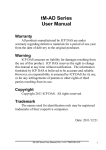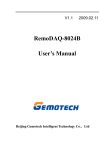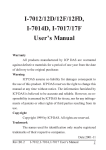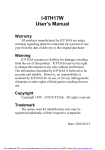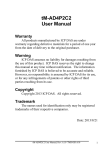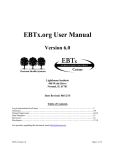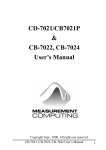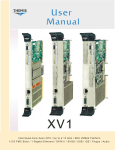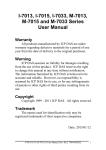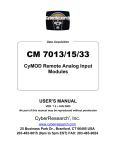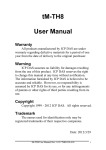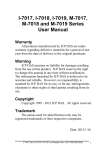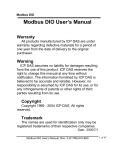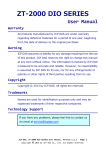Download M-7084 User Manual
Transcript
M-7084 User Manual Warranty All products manufactured by ICP DAS are under warranty regarding defective materials for a period of one year from the date of delivery to the original purchaser. Warning ICP DAS assumes no liability for damages resulting from the use of this product. ICP DAS reserves the right to change this manual at any time without notification. The information furnished by ICP DAS is believed to be accurate and reliable. However, no responsibility is assumed by ICP DAS for its use, or for any infringements of patents or other rights of third parties resulting from its use. Copyright Copyright 1999 - 2012 ICP DAS. All rights reserved. Trademark The names used for identification only may be registered trademarks of their respective companies. Date: 2012/12/7 M-7084 User Manual, Rev. A1.0 7PH-013-A10 1 Table of Contents 1. Introduction ..................................................................................... 5 1.1 More Information .................................................................... 6 1.2 Terminal Assignment .............................................................. 7 1.3 Specifications .......................................................................... 8 1.3.1 I/O Specifications........................................................... 8 1.3.2 System Specifications .................................................... 9 1.4 Block Diagram ...................................................................... 10 1.4.1 Block Diagram for the M-7084 .................................... 10 1.5 Dimensions............................................................................ 11 1.6 Wiring ................................................................................... 12 1.6.1 M-7084 Wiring............................................................. 12 1.6.2 Wiring Recommendations............................................ 12 1.7 Quick Start ............................................................................ 13 1.8 Default Settings..................................................................... 15 1.9 Configuration Tables............................................................. 16 1.10 M-7000 Notes...................................................................... 18 1.10.1 Protocol Switching ..................................................... 18 1.10.2 INIT Mode ................................................................. 19 1.11 Mounting ............................................................................. 20 1.11.1 Din-Rail Mounting ..................................................... 20 1.11.2 Piggyback Mounting .................................................. 22 1.11.3 Wall Mounting ........................................................... 23 1.12 Technical Support ............................................................... 24 2. DCON Protocol............................................................................. 25 2.1 %AANNTTCCFF ................................................................. 29 2.2 #AA ....................................................................................... 32 2.3 #AAN .................................................................................... 33 2.4 $AA0N .................................................................................. 35 2.5 $AA0N(Data)........................................................................ 37 2.6 $AA2 ..................................................................................... 39 2.7 $AA3N .................................................................................. 41 2.8 $AA3N(Data)........................................................................ 43 2.9 $AA4 ..................................................................................... 45 2.10 $AA4VV ............................................................................. 47 2.11 $AA5 ................................................................................... 49 2 M-7084 User Manual, Rev. A1.0 7PH-013-A10 2.12 $AA5VV ............................................................................. 51 2.13 $AA6 ................................................................................... 53 2.14 $AA6N ................................................................................ 55 2.15 $AA7 ................................................................................... 57 2.16 $AA7VV ............................................................................. 59 2.17 $AA7CNRVV ..................................................................... 61 2.18 $AA8CN ............................................................................. 63 2.19 $AAF................................................................................... 65 2.20 $AAI.................................................................................... 66 2.21 $AAM ................................................................................. 68 2.22 $AAP................................................................................... 69 2.23 $AAPN................................................................................ 71 2.24 @AABB .............................................................................. 73 2.25 @AABBVV ........................................................................ 75 2.26 @AAFA .............................................................................. 77 2.27 @AAFAVV ........................................................................ 79 2.28 @AAFH .............................................................................. 81 2.29 @AAFHVV ........................................................................ 83 2.30 @AAFT............................................................................... 85 2.31 @AAFTVV......................................................................... 87 2.32 @AAGN.............................................................................. 89 2.33 @AAGN(Data) ................................................................... 91 2.34 @AASC .............................................................................. 93 2.35 @AASCVV......................................................................... 95 2.36 ~**....................................................................................... 97 2.37 ~AA0................................................................................... 98 2.38 ~AA1................................................................................. 100 2.39 ~AA2................................................................................. 102 2.40 ~AA3EVV......................................................................... 104 2.41 ~AAI ................................................................................. 106 2.42 ~AAO(Name).................................................................... 108 2.43 ~AARD ............................................................................. 110 2.44 ~AARDVV ....................................................................... 112 2.45 ~AATnn ............................................................................ 114 3. Modbus RTU Protocol ................................................................ 117 3.1 M-7084 Modbus Address Mapping .................................... 118 4. Troubleshooting .......................................................................... 120 4.1 Communicating with the module ........................................ 121 M-7084 User Manual, Rev. A1.0 7PH-013-A10 3 A. Appendix .................................................................................... 122 A.1 INIT Mode.......................................................................... 122 A.2 Dual Watchdog Operation.................................................. 124 A.3 Frame Ground .................................................................... 125 A.4 Node Information Area ...................................................... 127 A.5 Reset Status ........................................................................ 128 A.6 Frequency Measurement .................................................... 129 4 M-7084 User Manual, Rev. A1.0 7PH-013-A10 1. Introduction The I-7000 series is a family of network data acquisition and control modules, providing analog-to-digital, digital-to-analog, digital input/output, timer/counter and other functions. The modules can be remotely controlled using a set of commands, which we call the DCON protocol. Communication between the module and the host is in ASCII format via an RS-485 bidirectional serial bus standard. Baud Rates are software programmable and transmission speeds of up to 115.2 Kbps can be selected. The functionality of the M-7000 series is the same as the I7000 series, with the exception that the M-7000 series offers extended support for the Modbus RTU protocol. Some M-7000 modules feature a new design for the frame ground and INIT switch as shown in the figure (rear view). The frame ground provides enhanced static protection (ESD) abilities and ensures the module is more reliable. The INIT switch allows easier access to INIT mode. Please refer to Sections A.1 and A.3 for more details. The M-7084 supports up counting, up-down counting, pulse direction counting, quadrature counting and frequency measurement. M-7084 User Manual, Rev. A1.0 7PH-013-A10 5 1.1 More Information For more information regarding the I-7000/M-7000 series, please refer to chapter 1 of the “I-7000 Bus Converter User’s Manual” as shown below or visit the ICP DAS website http://www.icpdas.com. 1.1 1.2 1.3 1.4 1.5 6 The 7000 Series Overview Related Documentation for the 7000 Series Common Features of the 7000 Series The 7000 Series System Network Configuration 7000 Dimensions For details of INIT mode operation, please refer to Section A.1 INIT Mode. For details of module watchdog and host watchdog, please refer to Section A.2 Dual Watchdog Operation. For details of ESD protection and grounding, please refer to Section A.3 Frame Ground. The node information area can be written with some information, please refer to Section A.4 Node Information Area for details. There is a way to check whether the module is reset, please refer to Section A.5 Reset Status for details. For details of frequency measurement, please refer to Section A.6 Frequency Measurement. M-7084 User Manual, Rev. A1.0 7PH-013-A10 1.2 Terminal Assignment M-7084 User Manual, Rev. A1.0 7PH-013-A10 7 1.3 Specifications 1.3.1 I/O Specifications Counter/Frequency/Encoder Input Channels 4-channel Up/Down Counter (CW/CCW) 4-channel Direction/Pulse Counter (Bidirection) 4-channel A/B Phase (Quadrant Counting) 8-channel Up Counter 8-channel Frequency Contact Wet Sink/Source (NPN/PNP) Sink Types Counter, Frequency, Encoder Counter/Encoder Bits 32-bit (4,294,967,295) On Voltage Level +3.5 VDC ~ +30 VDC Off Voltage Level +1 VDC Max. Programmable Digital Filter 1 ~ 32767 µs Individual Channel Configuration Yes Counter Mode Up, Up/Down Encoder Mode CW/CCW, Direction/Pulse, AB Phase Frequency Mode Yes Max. Speed 3.5 VDC ~ 10 VDC: 200 kHz 10 VDC ~ 30 VDC: 150 kHz Frequency Accuracy ±0.4% of Input Frequency Virtual Battery Backup to Preserve Yes Counter Values 8 M-7084 User Manual, Rev. A1.0 7PH-013-A10 1.3.2 System Specifications Communication Interface Format Baud Rate Protocol Dual Watchdog RS-485 N81, N82, E81, O81 1200 ~ 115200 bps Modbus RTU, DCON Yes, Module (1.6 Seconds), Communication (Programmable) LED Indicator Power Isolation Intra-module Isolation, Field-to-Logic EMS Protection ESD (IEC 61000-4-2) EFT (IEC 61000-4-4) Surge (IEC 61000-4-5) Power Reverse Polarity Protection Input Range Consumption Mechanical Dimensions (W x L x H) Installation Environment Operating Temperature Storage Temperature Humidity 1 LED, Red 3000 VDC +/-4 kV Contact for Each Terminal +/-4 kV for Power +/-3 kV for Power Line Yes 10 ~ 30 VDC 1.32 W Max. 72 mm x 123 mm x 35 mm DIN-Rail, Wall Mounting -25 ~ +75°C -30 ~ +80°C 10 ~ 90% RH, Non-condensing M-7084 User Manual, Rev. A1.0 7PH-013-A10 9 1.4 Block Diagram 1.4.1 Block Diagram for the M-7084 10 M-7084 User Manual, Rev. A1.0 7PH-013-A10 1.5 Dimensions lnit Normal Back View Side View Top View Unit : mm Front View M-7084 User Manual, Rev. A1.0 7PH-013-A10 11 1.6 Wiring 1.6.1 M-7084 Wiring 1.6.2 Wiring Recommendations 12 Use 26-12 AWG wire for signal connections. Strip the wire to a length of 7±0.5mm. Use a crimp terminal for wiring. Avoid high-voltage cables and power equipment as much as possible. For RS-485 communication, use insulated and twisted pair 24 AWG wire, e.g. Belden 9841. M-7084 User Manual, Rev. A1.0 7PH-013-A10 1.7 Quick Start To install the module, follow the steps below: 1. Refer to Section 1.2 for the terminal assignment and Section 1.6 for the wiring diagram. 2. Connect the module to the RS-485 network using the DATA+ and DATA- terminals. See Section 1.2 for the terminal assignment. If the host is only equipped with an RS-232 interface, then an RS-232 to RS-485 converter will be required. Refer to the “I-7000 Bus Converter User’s Manual” for more information. 3. Connect the module to the power supply using the +Vs and GND terminals. See Section 1.2 for the terminal assignment. Note that the voltage supplied to the module should be in the range of +10 to +30 VDC. 4. Configure the module by sending the %AANNTTCCFF command and the $AA7CNRVV command. See Section 2.1 and 2.17 for details. For M-7000 modules using the Modbus RTU protocol, configure the module using the following registers: 40257 ~ 40264, 40485, and 40486. The default settings for the module can be found in Section 1.8. 5. To read data from the input channels, send the #AAN command to the module. See Sections 2.3 for details. For M-7000 modules using the Modbus RTU protocol, use Function 03h to read the data from the input channels. 6. If the host is a PC with a Windows operating system installed, the DCON Utility can be used to allow easy configuration and reading of data. The DCON Utility can be downloaded from the ICP DAS website (http://www.icpdas.com). The documentation for the DCON Utility can be found in the ”Getting Started For I-7000 Series Modules” manual. M-7084 User Manual, Rev. A1.0 7PH-013-A10 13 Please refer to the “I-7000 Bus Converter User’s Manual” and ”Getting Started For I-7000 Series Modules” manuals for more details. The “Getting Started For I-7000 Series Modules” manual can be downloaded from the ICP DAS website (http://www.icpdas.com). 14 M-7084 User Manual, Rev. A1.0 7PH-013-A10 1.8 Default Settings Default settings for the M-7084 modules are as follows: 。 Protocol: Modbus RTU 。 Module Address: 01 。 Type: Type 50, up counter 。 Baud Rate: 9600 bps M-7084 User Manual, Rev. A1.0 7PH-013-A10 15 1.9 Configuration Tables Baud Rate Setting (CC) 7 6 5 Data Key Baud Data 4 3 2 0 Baud Description Baud Rate 03: 1200 04: 2400 05: 4800 06: 9600 07: 19200 08: 38400 09: 57600 0A: 115200 Data Format 0: eight data bits, no parity, and one stop bit 1: eight data bits, no parity, and two stop bit 2: eight data bits, even parity, and one stop bit 3: eight data bits, odd parity, and one stop bit Type Setting (TT) Type Code 50 51 54 55 56 16 1 Input Type Up counter Frequency Up/down counter Pulse/direction counter Quadrant counter M-7084 User Manual, Rev. A1.0 7PH-013-A10 Data Format Setting (FF) 7 RD Key DF CS RD 6 CS 5 4 3 2 1 RD 0 DF Description Data format 00: Engineering unit. The data consist of ‘+’, 6 digits and one decimal point. This data format is only for the frequency type. 10: Hexadecimal Checksum setting 0: Disabled 1: Enabled Reserved Note: The reserved bits should be zero. Counter Type and Data Format Table Type Code Counter type Data Format Up Hex Up/down Hex Pulse/direction Hex Hex Quadrant Min Max 50 54 55 56 00000000 80000000 80000000 80000000 FFFFFFFF 7FFFFFFF 7FFFFFFF 7FFFFFFF M-7084 User Manual, Rev. A1.0 7PH-013-A10 17 1.10 M-7000 Notes The main difference between the I-7000 and M-7000 series is that the M-7000 series has additional support for the Modbus RTU communication protocol, which is the default protocol of the M-7000 series. The communication Baud Rates for the Modbus RTU protocol can be in the range of 1200 bps to 115200 bps. Modbus functions supported by the module are described in Chapter 3. 1.10.1 Protocol Switching To switch to the DCON protocol: 1. Set Modbus register 00257 to 0. See Section 3.1 for details. 2. After a power-on reset, the communication protocol will be changed to DCON. To switch to the Modbus RTU protocol: 1. Sends the $AAPN command and set N to a value of 1. Note that for the modules without frame ground, the INIT* terminal should be connected to the GND terminal, and for the modules with frame ground, the slide switch on the rear side of the module should be set to the INIT position, see the figure on the next page. See Section 2.23 for details. 2. After a power-on reset, the communication protocol will be changed to the Modbus RTU protocol. 18 M-7084 User Manual, Rev. A1.0 7PH-013-A10 1.10.2 INIT Mode When the module is powered on, with the rear slide switch set to the INIT position as shown in the figure below for modules with frame ground, or with the INIT* pin connected to the GND pin for modules without frame ground, the module is in INIT mode, (see Section A.1 for details), and the communication settings are as follows: 1. 2. 3. 4. Address: 00 Baud Rate: 9600 bps No checksum Protocol: DCON If communication with the module is not possible, set the module to the INIT mode and use the above settings to communicate with the module. To read the current settings, send the commands $AA2, (see Section 2.6), and $AAP, (see Section 2.22). To set new settings, send the commands %AANNTTCCFF, (see Section 2.1) and $AAPN, (see Section 2.23). The new communication settings will be effective after the next power-on reset. M-7084 User Manual, Rev. A1.0 7PH-013-A10 19 1.11 Mounting 1.11.1 Din-Rail Mounting There are three new DIN rail models available. Each is made of stainless steel, which is stronger than those made of aluminum. There is a screw at one end and a ring terminal is included so that it can be easily connected to the earth ground. The three new DIN rail models are as follows. Part number DRS-360 20 Max. number of modules 5 Dimensions 360mm x 35mm M-7084 User Manual, Rev. A1.0 7PH-013-A10 Part number DRS-240 Max. number of modules 3 Dimensions 240mm x 35mm Part number DRS-125 Max. number of modules 2 Dimensions 125mm x 35mm Note: It is recommended that a 16 – 14 AWG wire is used to connect the DIN rail to the earth ground. M-7084 User Manual, Rev. A1.0 7PH-013-A10 21 1.11.2 Piggyback Mounting 22 M-7084 User Manual, Rev. A1.0 7PH-013-A10 1.11.3 Wall Mounting M-7084 User Manual, Rev. A1.0 7PH-013-A10 23 1.12 Technical Support Should you encounter any problems while using the I-7000 and M-7000 module, and are unable to find the help you need in this manual or on our website, please contact ICP DAS Product Support. Email: [email protected] Website: http://www.icpdas.com.tw/contact_us/contact_us.html When requesting technical support, be prepared to provide the following information about your system: 1. Module name and serial number: The serial number can be found printed on the barcode label attached to the cover of the module. 2. Firmware version: See Sections 2.19 and 3.1 for information regarding the command used to identify the firmware version. 3. Host configuration (type and operating system) 4. If the problem is reproducible, please give full details describing the procedure used to reproduce the problem. 5. Any specific error messages displayed. If a dialog box with an error message is displayed, please include the full text of the dialog box, including the text in the title bar. 6. If the problem involves other programs or hardware devices, please describe the details of the problem in full. 7. Any comments and suggestions related to the problem are welcome. ICP DAS will reply to your request by email within three business days. 24 M-7084 User Manual, Rev. A1.0 7PH-013-A10 2. DCON Protocol All communication with I-7000 modules consists of commands generated by the host and responses transmitted by the I-7000 modules. Each module has a unique ID number that is used for addressing purposes and is stored in nonvolatile memory. The ID is 01 by default and can be changed using a user command. All commands to the modules contain the ID address, meaning that only the addressed module will respond. The only exception to this is command ~** (Section 2.36), which is sent to all modules, but the modules do not reply to the command. Command Format: Leading Character Module Address Command [CHKSUM] CR Response Format: Leading Character CHKSUM CR Module Address Data [CHKSUM] CR A 2-character checksum which is present when the checksum setting is enabled. See Sections 1.9 (Data Format Setting) and 2.1 for details. End of command character, carriage return (0x0D) M-7084 User Manual, Rev. A1.0 7PH-013-A10 25 Checksum Calculation: 1. Calculate the ASCII code sum of all the characters in the command/response string except for the carriage return character (CR). 2. The checksum is equal to the sum masked by 0FFh. Example: Command string: $012(CR) 1. Sum of the string = “$”+”0”+”1”+”2” = 24h+30h+31h+32h = B7h 2. Therefore the checksum is B7h, and so CHKSUM = “B7” 3. The command string with the checksum = $012B7(CR) Response string: !01200600(CR) 1. Sum of the string = “!”+”0”+”1”+”2”+”0”+”0”+”6”+”0”+”0” = 21h+30h+31h+32h+30h+30h+36h+30h+30h = 1AAh 2. Therefore the checksum is AAh, and so CHKSUM = “AA” 3. The response string with the checksum = !01200600AA(CR) Note: All characters should be in upper case. 26 M-7084 User Manual, Rev. A1.0 7PH-013-A10 General Command Sets Command %AANNTTCCFF $AA2 $AA5 $AAF $AAI $AAM $AAP $AAPN ~AAI ~AAO(Name) ~AARD ~AARDVV ~AATnn Section !AA Sets the Module Configuration 2.1 !AANNTTCCFF Reads the Module Configuration 2.6 !AAS Reads the Reset Status 2.11 !AA(Data) Reads the firmware Version 2.19 !AAS Reads the INIT Status 2.20 !AA(Data) Reads the Module Name 2.21 !AASC Reads the communication protocol 2.22 !AA Sets the communication protocol 2.23 !AA Software INIT 2.41 !AA Sets the Module Name 2.42 !AAVV Reads the Response Delay Time 2.43 !AA Sets the Response Delay Time 2.44 !AA Sets the Software INIT Timeout 2.45 Response Description Counter/Frequency Command Sets Command Response Description Section Reads the Input Data of All 2.2 Channels Reads the Input Data of the 2.3 Specified Channel Reads the Low Pass Filter Time of 2.4 the Specified Channel Sets the Low Pass Filter Time of the 2.5 Specified Channel Reads the Maximum Counter Value 2.7 of the Specified Channel Sets the Maximum Counter Value of 2.8 the Specified Channel Reads the Low Pass Filter Channel 2.9 Mask Sets the Low Pass Filter Channel 2.10 Mask #AA >(Data) #AAN >(Data) $AA0N !AA(Data) $AA0N(Data) !AA $AA3N !AA(Data) $AA3N(Data) !AA $AA4 !AAVV $AA4VV !AA $AA5VV !AA Starts/Stop Counting 2.12 $AA6 !AAVV Reads the Start/Stop Counting Status 2.13 M-7084 User Manual, Rev. A1.0 7PH-013-A10 27 Command Response Description Clears the Counter Value of the Specified Channel Shows the Overflow Status of All Channels Section 2.14 $AA6N !AA $AA7 !AAVV $AA7VV !AA Clears the Overflow Status $AA7CNRVV !AA Sets the Single Channel Type 2.16 2.17 $AA8CN !AACNRVV Reads the Channel Type of the Specified Channel 2.18 @AABB !AAVV Reads the Battery Backup Status @AABBVV !AA Sets the Battery Backup Status @AAFA !AAVV @AAFAVV !AA @AAFH !AAVV @AAFHVV !AA @AAFT !AAVV @AAFTVV !AA @AAGN !AA(Data) @AAPN(Data) !AA @AASC !AAVV @AASCVV !AA Command Reads the Auto Frequency Mode Status Sets the Auto Frequency Mode Status Reads the High Frequency Mode Status Sets the High Frequency Mode Status Reads the Frequency Measurement Timeout Sets the Frequency Measurement Timeout Reads the Preset Counter Value of the Specified Channel Sets the Preset Counter Value of the Specified Channel e Reads the Stop Counting on Overflow Status Sets the Stop Counting on Overflow Status Host Watchdog Command Sets Response Description ~** No Response Host OK ~AA0 !AASS Reads the Status ~AA1 !AA Resets the Status ~AA2 !AAVV Reads the Timeout Settings ~AA3EVV !AA Sets the Timeout Settings 28 M-7084 User Manual, Rev. A1.0 7PH-013-A10 2.15 2.24 2.25 2.26 2.27 2.28 2.29 2.30 2.31 2.32 2.33 2.34 2.35 Section 2.36 2.37 2.38 2.39 2.40 2.1 %AANNTTCCFF Description: Sets the configuration of a module. Syntax: %AANNTTCCFF[CHKSUM](CR) % Delimiter character AA Address of the module to be configured in hexadecimal format (00 to FF) NN New address of the module in hexadecimal format (00 to FF) TT New type code. Not used by the M-7084. It should be set to 00 for the M-7084 CC New Baud Rate code, see Section 1.9 for details. The INIT* pin must be connected to ground in order to change Baud Rates. For the module with frame ground, this is achieved by moving the rear slide switch to the INIT position. See Section A.1 for details. FF Used to set the data format and checksum (Section 1.9). The INIT* pin must be connected to ground in order to change the checksum setting. For the module with frame ground, this is achieved by moving the rear slide switch to the INIT position. See Section A.1 for details. M-7084 User Manual, Rev. A1.0 7PH-013-A10 29 Response: Valid Command: !AA[CHKSUM](CR) Invalid Command: ?AA[CHKSUM](CR) ! Delimiter for a valid command ? Delimiter for an invalid command. If the Baud Rate or checksum settings are changed without connecting the INIT* pin to ground or switching the rear slide switch to the INIT position, the module will return an invalid command. AA Address of the module in hexadecimal format (00 to FF) There will be no response if the command syntax is incorrect, there is a communication error, or there is no module with the specified address. Examples: Command: %0102000600 Response: !02 Changes the address of module 01 to 02. The module returns a valid response. Command: %0101000A00 Response: ?01 Changes the Baud Rate of module 01 to 115200bps. The module returns an invalid command, because it is not in INIT* mode. Command: %0101000A00 Response: !01 Changes the Baud Rate of module 01 to 115200bps and the module is in INIT* mode. The module returns a valid response. 30 M-7084 User Manual, Rev. A1.0 7PH-013-A10 Related Commands: Section 2.6 $AA2, Section 2.41 ~AAI, Section 2.45 ~AATnn Related Topics: Section 1.9 Configuration Tables, Section A.1 INIT* pin Operation Notes: 1. Changes to the address and data format settings take effect immediately after a valid command is received. Changes to the Baud Rate and checksum settings take effect on the next power-on reset. 2. For the M-7084, changing the Baud Rate and checksum settings can be achieved using software only and is performed using the following commands: I. Send a ~AATnn command. See Section 2.45 for details. II. Send a ~AAI command. See Section 2.41 for details. III. Send a %AANNTTCCFF command. If the command is valid, the Baud Rate and checksum settings will be changed after the module responds with !AA. M-7084 User Manual, Rev. A1.0 7PH-013-A10 31 2.2 #AA Description: Reads the data from every input channels. Syntax: #AA[CHKSUM](CR) # Delimiter character AA Address of the module to be read (00 to FF) Response: Valid Response: >(Data)[CHKSUM](CR) Invalid Response: ?AA[CHKSUM](CR) > Delimiter character for a valid response ? Delimiter character for an invalid response (Data) Data from every input channels, see Section 1.9 for the details of data format. There will be no response if the command syntax is incorrect, there is a communication error, or there is no module with the specified address. Examples: Command: #01 Response: >000012340000567800009ABC0000DEF000001111000022 220000333300004444 Reads module 01 and receives the data. Related Commands: Section 2.1 %AANNTTCCFF, Section 2.6 $AA2 Related Topics: Section 1.9 Configuration Tables 32 M-7084 User Manual, Rev. A1.0 7PH-013-A10 2.3 #AAN Description: Reads the input of channel N. Syntax: #AAN[CHKSUM](CR) # Delimiter character AA Address of the module to be read (00 to FF) N The channel to be read, zero based. Response: Valid Response: >(Data)[CHKSUM](CR) Invalid Response: ?AA[CHKSUM](CR) > Delimiter character for a valid response ? Delimiter character for an invalid response. An invalid command is returned if the specified channel is incorrect. (Data) Input data of the specified channel, see Section 1.9 for details of the data format. AA Address of the responding module (00 to FF) There will be no response if the command syntax is incorrect, there is a communication error, or there is no module with the specified address. M-7084 User Manual, Rev. A1.0 7PH-013-A10 33 Examples: Command: #032 Response: >00001234 Reads data from channel 2 of module 03. Command: #029 Response: ?02 Reads data from channel 9 of module 02. An error is returned because channel 9 is invalid. Related Commands: Section 2.1 %AANNTTCCFF, Section 2.6 $AA2 Related Topics: Section 1.9 Configuration Tables 34 M-7084 User Manual, Rev. A1.0 7PH-013-A10 2.4 $AA0N Description: Reads the low pass filter time of channel N. Syntax: $AA0N[CHKSUM](CR) $ Delimiter character AA Address of the module to be set (00 to FF) 0 Command to read the low pass filter time of a channel N Specifies the channel to be read (0 ~ 7) Response: Valid command: !AA(Data)[CHKSUM](CR) Invalid command: ?AA[CHKSUM](CR) ! Delimiter character for a valid command ? Delimiter character for an invalid command AA Address of the responding module (00 to FF) (Data) Low pass filter time is micro seconds, consisting of 5 decimal digits in the range 00001 ~ 32767. There will be no response if the command syntax is incorrect, there is a communication error, or there is no module with the specified address. M-7084 User Manual, Rev. A1.0 7PH-013-A10 35 Examples: Command: $0103 Response: !0100010 Reads the channel 3 low pass filter time of module 01 and the module responds with 00010 which means 10 micro seconds. Related Commands: Section 2.5 $AA0N(data), Section 2.9 $AA4, Section 2.10 $AA4vv Notes: 1. The low pass filter time should be the same for channel 0 and 1. When it is set to either one of the channel 0 or 1, both channels will be set to the same value. 2. The low pass filter time should be the same for channel 2 and 3. When it is set to either one of the channel 2 or 3, both channels will be set to the same value. 3. The low pass filter time should be the same for channel 4, 5, 6 and 7. When it is set to either one of the channel 4, 5, 6 or 7, all of the 4 channels will be set to the same value. 36 M-7084 User Manual, Rev. A1.0 7PH-013-A10 2.5 $AA0N(Data) Description: Sets the low pass filter time of a channel. Syntax: $AA0N(Data)[CHKSUM](CR) $ Delimiter character AA Address of the module to be set (00 to FF) 0 Command to read the low pass filter time of a channel N Specifies the channel to be read (0 ~ 7) (Data) Low pass filter time is micro seconds, consisting of 5 decimal digits in the range 00001 ~ 32767. Response: Valid command: !AA(Data)[CHKSUM](CR) Invalid command: ?AA[CHKSUM](CR) ! Delimiter character for a valid command ? Delimiter character for an invalid command AA Address of the responding module (00 to FF) There will be no response if the command syntax is incorrect, there is a communication error, or there is no module with the specified address. M-7084 User Manual, Rev. A1.0 7PH-013-A10 37 Examples: Command: $010300010 Response: !01 Sets the channel 3 low pass filter time of module 01 to 10 micro seconds and returns a valid response. Related Commands: Section 2.4 $AA0N, Section 2.9 $AA4, Section 2.10 $AA4vv Notes: 1. The low pass filter time should be the same for channel 0 and 1. When it is set to either one of the channel 0 or 1, both channels will be set to the same value. 2. The low pass filter time should be the same for channel 2 and 3. When it is set to either one of the channel 2 or 3, both channels will be set to the same value. 3. The low pass filter time should be the same for channel 4, 5, 6 and 7. When it is set to either one of the channel 4, 5, 6 or 7, all of the 4 channels will be set to the same value. 38 M-7084 User Manual, Rev. A1.0 7PH-013-A10 2.6 $AA2 Description: Reads the module configuration. Syntax: $AA2[CHKSUM](CR) $ Delimiter character AA Address of the module to be read (00 to FF) 2 Command to read the module configuration Response: Valid Command: !AATTCCFF[CHKSUM](CR) Invalid Command: ?AA[CHKSUM](CR) ! Delimiter character for a valid command ? Delimiter character for an invalid command AA Address of the responding module (00 to FF) TT Type code of the module, should be 00 for M-7084. CC Baud Rate code of the module, see Section 1.9 for details. FF Checksum and counter update direction settings of the module, see Section 1.9 for details. There will be no response if the command syntax is incorrect, there is a communication error, or there is no module with the specified address. M-7084 User Manual, Rev. A1.0 7PH-013-A10 39 Examples: Command: $012 Response: !01000600 Reads the configuration of module 01. Related Commands: Section 2.1 %AANNTTCCFF Related Topics: Section 1.9 Configuration Tables 40 M-7084 User Manual, Rev. A1.0 7PH-013-A10 2.7 $AA3N Description: Reads the maximum counter value of channel N. Syntax: $AA3N[CHKSUM](CR) $ Delimiter character AA Address of the module to be set (00 to FF) 3 Command to read the maximum counter value of a channel N Specifies the channel to be read (0 ~ 7) Response: Valid command: !AA(Data)[CHKSUM](CR) Invalid command: ?AA[CHKSUM](CR) ! Delimiter character for a valid command ? Delimiter character for an invalid command AA Address of the responding module (00 to FF) (Data) The maximum counter value in eight hexadecimal digits There will be no response if the command syntax is incorrect, there is a communication error, or there is no module with the specified address. M-7084 User Manual, Rev. A1.0 7PH-013-A10 41 Examples: Command: $0132 Response: !01FFFFFFFF Reads the channel 2 maximum counter value of module 01 and the module responds with FFFFFFFF. Related Commands: Section 2.8 $AA3N(Data) Note: The maximum counter value is only available to the channels that are set to up counter type (type code 50). 42 M-7084 User Manual, Rev. A1.0 7PH-013-A10 2.8 $AA3N(Data) Description: Sets the maximum counter value of a channel. Syntax: $AA3N(Data)[CHKSUM](CR) $ Delimiter character AA Address of the module to be set (00 to FF) 3 Command to set the maximum counter value of a channel N Specifies the channel to be read (0 ~ 7) (Data) The maximum counter value in eight hexadecimal digits Response: Valid command: !AA(Data)[CHKSUM](CR) Invalid command: ?AA[CHKSUM](CR) ! Delimiter character for a valid command ? Delimiter character for an invalid command AA Address of the responding module (00 to FF) There will be no response if the command syntax is incorrect, there is a communication error, or there is no module with the specified address. M-7084 User Manual, Rev. A1.0 7PH-013-A10 43 Examples: Command: $0132F0000000 Response: !01 Sets the channel 2 maximum counter value of module 01 to 0xF0000000 and returns a valid response. Related Commands: Section 2.7 $AA3N Note: The maximum counter value is only available to the channels that are set to up counter type (type code 50). 44 M-7084 User Manual, Rev. A1.0 7PH-013-A10 2.9 $AA4 Description: Reads the enabled/disabled low pass filter status of each channel. Syntax: $AA4[CHKSUM](CR) $ Delimiter character AA Address of the module to be read (00 to FF) 4 Command to read the low pass filter status Response: Valid Command: !AAVV[CHKSUM](CR) Invalid Command: ?AA[CHKSUM](CR) ! Delimiter character for a valid command ? Delimiter character for an invalid command AA Address of the responding module (00 to FF) VV A two-digit hexadecimal value, where bit 0 corresponds to channel 0, bit 1 corresponds to channel 1, etc. When the bit is 1 it means that the low pass filter is enable for the channel and 0 means that the low pass filter is disabled for the channel. There will be no response if the command syntax is incorrect, there is a communication error, or there is no module with the specified address. M-7084 User Manual, Rev. A1.0 7PH-013-A10 45 Examples: Command: $014 Response: !013A Reads the low pass filter enabled/disabled status for module 01 and returns a response of 3A, meaning that low pass filter for channels 1, 3, 4, and 5 are enabled and disabled for all other channels. Related Commands: Section 2.10 $AA4VV 46 M-7084 User Manual, Rev. A1.0 7PH-013-A10 2.10 $AA4VV Description: Specifies the channel(s) which low pass filter should be enabled. Syntax: $AA4VV[CHKSUM](CR) $ Delimiter character AA Address of the module to be read (00 to FF) 4 Command to enable/disable the low pass filter VV A two-digit hexadecimal value, where bit 0 corresponds to channel 0, bit 1 corresponds to channel 1, etc. When the bit is 1 it means that the low pass filter is enable for the channel and 0 means that the low pass filter is disabled for the channel. Response: Valid Command: !AAVV[CHKSUM](CR) Invalid Command: ?AA[CHKSUM](CR) ! Delimiter character for a valid command ? Delimiter character for an invalid command AA Address of the responding module (00 to FF) There will be no response if the command syntax is incorrect, there is a communication error, or there is no module with the specified address. M-7084 User Manual, Rev. A1.0 7PH-013-A10 47 Examples: Command: $0143A Response: !01 Enables the low pass filter of channels 1, 3, 4, and 5 and disables all other channels of module 01. The module returns a valid response. Related Commands: Section 2.9 $AA4 48 M-7084 User Manual, Rev. A1.0 7PH-013-A10 2.11 $AA5 Description: Reads the reset status of a module. Syntax: $AA5[CHKSUM](CR) $ Delimiter character AA Address of the module to be read (00 to FF) 5 Command to read the module reset status Response: Valid Command: !AAS[CHKSUM](CR) Invalid Command: ?AA[CHKSUM](CR) ! Delimiter character for a valid command ? Delimiter character for an invalid command AA Address of the responding module (00 to FF) S Reset status of the module 1: This is the first time the command has been sent since the module was powered on. 0: This is not the first time the command has been sent since the module was powered on, which denotes that there has been no module reset since the last $AA5 command was sent. There will be no response if the command syntax is incorrect, there is a communication error, or there is no module with the specified address. M-7084 User Manual, Rev. A1.0 7PH-013-A10 49 Examples: Command: $015 Response: !011 Reads the reset status of module 01. The response shows that it is the first time the $AA5 command has been sent since the module was powered-on. Command: $015 Response: !010 Reads the reset status of module 01. The response shows that there has been no module reset since the last $AA5 command was sent. Related Topics: Section A.5 Reset Status 50 M-7084 User Manual, Rev. A1.0 7PH-013-A10 2.12 $AA5VV Description: Specifies the channel(s) to count. Syntax: $AA5VV(VV)[CHKSUM](CR) $ Delimiter character AA Address of the module to be set (00 to FF) 5 Command to start counting VV A two-digit hexadecimal value, where bit 0 corresponds to channel 0, bit 1 corresponds to channel 1, etc. When the bit is 1 it means that the channel is counting and 0 means that the channel is not counting. Response: Valid Response: !AA[CHKSUM](CR) Invalid Response: ?AA[CHKSUM](CR) ! Delimiter character for a valid response ? Delimiter character for an invalid response. An invalid command is returned if an attempt is made to enable a channel that is not present. AA Address of the responding module (00 to FF) There will be no response if the command syntax is incorrect, there is a communication error, or there is no module with the specified address. M-7084 User Manual, Rev. A1.0 7PH-013-A10 51 Examples: Command: $0153A Response: !01 Sets channels 1, 3, 4, and 5 to count and all other channels not counting for module 01. The module returns a valid response. Command: $016 Response: !013A Reads the counting status of module 01 and returns a response of 3A, meaning that channels 1, 3, 4, and 5 are counting and all other channels are not counting. Related Commands: Section 2.13 $AA6 Note: The command is not available to the channels that are set to type code 51, frequency measurement. 52 M-7084 User Manual, Rev. A1.0 7PH-013-A10 2.13 $AA6 Description: Reads the start/stop counting status of each channel. Syntax: $AA6[CHKSUM](CR) $ Delimiter character AA Address of the module to be read (00 to FF) 6 Command to read the channel counting status Response: Valid Response: !AAVV(VV)[CHKSUM](CR) Invalid Response: ?AA[CHKSUM](CR) ! Delimiter character for a valid response ? Delimiter character for an invalid response AA Address of the responding module (00 to FF) VV A two-digit hexadecimal value, where bit 0 corresponds to channel 0, bit 1 corresponds to channel 1, etc. When the bit is 1 it means that the channel is counting and 0 means that the channel is not counting. There will be no response if the command syntax is incorrect, there is a communication error, or there is no module with the specified address. M-7084 User Manual, Rev. A1.0 7PH-013-A10 53 Examples: Command: $0153A Response: !01 Sets channels 1, 3, 4, and 5 to count and all other channels not counting for module 01. The module returns a valid response. Command: $016 Response: !013A Reads the counting status of module 01 and returns a response of 3A, meaning that channels 1, 3, 4, and 5 are counting and all other channels are not counting. Related Commands: Section 2.12 $AA5VV Note: The command is not available to the channels that are set to type code 51, frequency measurement. 54 M-7084 User Manual, Rev. A1.0 7PH-013-A10 2.14 $AA6N Description: Sets the counter value of a channel to preset value. Syntax: $AA6N[CHKSUM](CR) $ Delimiter character AA Address of the module to be read (00 to FF) 6 Command to clear the counter value N Specifies the channel to be cleared (0 ~ 7) Response: Valid command: !AA[CHKSUM](CR) Invalid command: ?AA[CHKSUM](CR) ! Delimiter character for a valid command ? Delimiter character for an invalid command AA Address of the responding module (00 to FF) There will be no response if the command syntax is incorrect, there is a communication error, or there is no module with the specified address. M-7084 User Manual, Rev. A1.0 7PH-013-A10 55 Examples: Command: $0161 Response: !01 Clears the counter value of channel 1 of module 01 and the module returns a valid response. Related Commands: Section 2.15 $AA7 Notes: 1. The overflow status is cleared by the command, too. 2. The command is not available to the channels that are set to type code 51, frequency measurement. 56 M-7084 User Manual, Rev. A1.0 7PH-013-A10 2.15 $AA7 Description: Reads the counter overflow status of each channel. Syntax: $AA7[CHKSUM](CR) $ Delimiter character AA Address of the module to be read (00 to FF) 7 Command to read the counter overflow status Response: Valid Command: !AAVV[CHKSUM](CR) Invalid Command: ?AA[CHKSUM](CR) ! Delimiter character for a valid command ? Delimiter character for an invalid command AA Address of the responding module (00 to FF) VV A two-digit hexadecimal value, where bit 0 corresponds to channel 0, bit 1 corresponds to channel 1, etc. For type code 50, when the bit is 1 it means that the counter of the channel is overflowed and 0 means that the counter of the channel is not overflowed. For type code 54 ~ 56, the overflow status is represented by two bits. 00: no over/underflow 01: overflow 10: underflow 11: not applicable M-7084 User Manual, Rev. A1.0 7PH-013-A10 57 There will be no response if the command syntax is incorrect, there is a communication error, or there is no module with the specified address. Examples: Command: $017 Response: !013A Reads the counter overflow status for module 01 and returns a response of 3A, meaning that counters of channels 1, 3, 4, and 5 are overflowed. Related Commands: Section 2.16 $AA7VV Note: The command is not available to the channels that are set to type code 51, frequency measurement. 58 M-7084 User Manual, Rev. A1.0 7PH-013-A10 2.16 $AA7VV Description: Specifies the channels which counter overflow status are to be cleared. Syntax: $AA7VV[CHKSUM](CR) $ Delimiter character AA Address of the module to be read (00 to FF) 7 Command to clear the counter overflow status VV A two-digit hexadecimal value, where bit 0 corresponds to channel 0, bit 1 corresponds to channel 1, etc. When the bit is 1 it means that the counter overflow status of the channel should be cleared. Response: Valid Command: !AAVV[CHKSUM](CR) Invalid Command: ?AA[CHKSUM](CR) ! Delimiter character for a valid command ? Delimiter character for an invalid command AA Address of the responding module (00 to FF) There will be no response if the command syntax is incorrect, there is a communication error, or there is no module with the specified address. M-7084 User Manual, Rev. A1.0 7PH-013-A10 59 Examples: Command: $0173A Response: !01 Clears the counter overflow status of channels 1, 3, 4, and 5 for module 01 and returns a valid response. Related Commands: Section 2.15 $AA7 Note: The command is not available to the channels that are set to type code 51, frequency measurement. 60 M-7084 User Manual, Rev. A1.0 7PH-013-A10 2.17 $AA7CNRVV Description: Sets the type code of a channel. Syntax: $AA7CNRVV[CHKSUM](CR) $ Delimiter character AA Address of the module to be set (00 to FF) 7 Command to set the channel range code CN N specifies the input channel to be set (0-7) RVV VV represents the type code of the channel to be set. Refer to the Analog Input Type Setting table in Section 1.9 for details. Response: Valid Response: !AA [CHKSUM](CR) Invalid Response: ?AA[CHKSUM](CR) ! Delimiter character for a valid response ? Delimiter character for an invalid response or invalid type code There will be no response if the command syntax is incorrect, there is a communication error, or there is no module with the specified address. M-7084 User Manual, Rev. A1.0 7PH-013-A10 61 Examples: Command: $017C0R50 Response: !01 Sets the type code for channel 0 of module 01 to be 50 (up counting) and the module returns a valid response. Command: $037C1R30 Response: ?03 Sets the type code for channel 1 of module 03 to be 30. The module returns an invalid response because the type code is invalid. Related Commands: Section 2.18 $AA8CN Related Topics: Section 1.9 Configuration Tables Note: If the type code of a channel is set to one of 54 ~ 56, then the adjacent channel in the same pair will be set to the same type code. 62 M-7084 User Manual, Rev. A1.0 7PH-013-A10 2.18 $AA8CN Description: Reads the type code information of a channel. Syntax: $AA8CN[CHKSUM](CR) $ Delimiter character AA Address of the module to be read (00 to FF) 8 Command to read the type code of a channel CN N specifies which channel to access for the type code information (N=0-7). Response: Valid Response: !AACNRVV[CHKSUM](CR) Invalid Response: ?AA[CHKSUM](CR) ! Delimiter character for a valid response ? Delimiter character for an invalid response or invalid channel AA Address of the responding module (00 to FF) CN N specifies which input channel to access to retrieve the type code information. RVV VV represents the type code of the specified input channel. Refer to the Analog Input Type Setting table in Section 1.9 for details. M-7084 User Manual, Rev. A1.0 7PH-013-A10 63 There will be no response if the command syntax is incorrect, there is a communication error, or there is no module with the specified address. Examples: Command: $018C0 Response: !01C0R50 Reads the channel 0 input range of module 01 and returns 50 (up counting). Related Commands: Section 2.17 $AA7CNRVV Related Topics: Section 1.9 Configuration Tables 64 M-7084 User Manual, Rev. A1.0 7PH-013-A10 2.19 $AAF Description: Reads the firmware version of a module. Syntax: $AAF[CHKSUM](CR) $ Delimiter character AA Address of the module to be read (00 to FF) F Command to read the firmware version Response: Valid command: !AA(Data)[CHKSUM](CR) Invalid command: ?AA[CHKSUM](CR) ! Delimiter character for a valid command ? Delimiter character for an invalid command AA Address of the responding module (00 to FF) (Data) Firmware version string of the module There will be no response if the command syntax is incorrect, there is a communication error, or there is no module with the specified address. Examples: Command: $01F Response: !01A2.0 Reads the firmware version of module 01, and shows that it is version A2.0. Command: $02F Response: !02B1.1 Reads the firmware version of module 02, and shows that it is version B1.1. M-7084 User Manual, Rev. A1.0 7PH-013-A10 65 2.20 $AAI Description: Reads the INIT status. Syntax: $AAI[CHKSUM](CR) $ Delimiter character AA Address of the module to be read (00 to FF) I Command to read the INIT status Response: Valid Response: !AAS[CHKSUM](CR) Invalid Response: ?AA[CHKSUM](CR) ! Delimiter character for a valid response ? Delimiter character for an invalid response AA Address of the responding module (00 to FF) S INIT status: 0= the INIT pin is shorted to GND. 1= the INIT pin is not shorted to GND. 2= Update CJC temperature once only. There will be no response if the command syntax is incorrect, there is a communication error, or there is no module with the specified address. 66 M-7084 User Manual, Rev. A1.0 7PH-013-A10 Examples: Command: $01I Response: !010 Reads the INIT status of module 01 and the module responds with 0, meaning that the INIT pin is shorted to GND. M-7084 User Manual, Rev. A1.0 7PH-013-A10 67 2.21 $AAM Description: Reads the name of a module. Syntax: $AAM[CHKSUM](CR) $ Delimiter character AA Address of the module to be read (00 to FF) M Command to read the module name Response: Valid command: !AA(Data)[CHKSUM](CR) Invalid command: ?AA[CHKSUM](CR) ! Delimiter character for a valid command ? Delimiter character for an invalid command AA Address of the responding module (00 to FF) (Name) Name string of the module There will be no response if the command syntax is incorrect, there is a communication error, or there is no module with the specified address. Examples: Command: $01M Response: !017084 Reads the module name of module 01 and returns the name “7084”. Related Commands: Section 2.23 ~AAO(Name) 68 M-7084 User Manual, Rev. A1.0 7PH-013-A10 2.22 $AAP Description: Reads the communication protocol information. Syntax: $AAP[CHKSUM](CR) $ Delimiter character AA Address of the module to be read (00 to FF) P Command to read the communication protocol Response: Valid Response: !AASC[CHKSUM](CR) Invalid Response: ?AA[CHKSUM](CR) ! Delimiter character for a valid response ? Delimiter character for an invalid response AA Address of the responding module (00 to FF) S The protocols supported by the module 0: only DCON protocol is supported 1: both the DCON and Modbus RTU protocols are supported C The current protocol that is saved in the EEPROM that will be used at the next power-on reset 0: the protocol set in the EEPROM is DCON 1: the protocol set in the EEPROM is Modbus RTU There will be no response if the command syntax is incorrect, there is a communication error, or there is no module with the specified address. M-7084 User Manual, Rev. A1.0 7PH-013-A10 69 Examples: Command: $01P Response: !0110 Reads the communication protocol of module 01 and returns a response of 10 meaning that it supports both the DCON and Modbus RTU protocols and the protocol that will be used at the next power-on reset is DCON. Related Commands: Section 2.23 $AAPN 70 M-7084 User Manual, Rev. A1.0 7PH-013-A10 2.23 $AAPN Description: Sets the communication protocol. Syntax: $AAPN[CHKSUM](CR) $ Delimiter character AA Address of the module to be read (00 to FF) P Command to set the communication protocol N 0: DCON protocol 1: Modbus RTU protocols Before using this command, the rear slide switch must be in the INIT position. The new protocol is saved in the EEPROM and will be effective after the next power-on reset. Response: Valid Response: !AASC[CHKSUM](CR) Invalid Response: ?AA[CHKSUM](CR) ! Delimiter character for a valid response ? Delimiter character for an invalid response AA Address of the responding module (00 to FF) There will be no response if the command syntax is incorrect, there is a communication error, or there is no module with the specified address. M-7084 User Manual, Rev. A1.0 7PH-013-A10 71 Examples: Command: $01P1 Response: ?01 Sets the communication protocol of module 01 to Modbus RTU and returns an invalid response because the module is not in INIT mode. Command: $01P1 Response: !01 Sets the communication protocol of module 01 to Modbus RTU and returns a valid response. Related Commands: Section 2.22 $AAP 72 M-7084 User Manual, Rev. A1.0 7PH-013-A10 2.24 @AABB Description: Reads the battery backup counter status of each channel. Syntax: @AABB[CHKSUM](CR) @ Delimiter character AA Address of the module to be read (00 to FF) BB Command to read the battery backup counter status Response: Valid Command: !AAVV[CHKSUM](CR) Invalid Command: ?AA[CHKSUM](CR) ! Delimiter character for a valid command ? Delimiter character for an invalid command AA Address of the responding module (00 to FF) VV A two-digit hexadecimal value, where bit 0 corresponds to channel 0, bit 1 corresponds to channel 1, etc. When the bit is 1 it means that the battery backup counter is enabled for the channel and 0 means that the battery backup counter is disabled for the channel. There will be no response if the command syntax is incorrect, there is a communication error, or there is no module with the specified address. M-7084 User Manual, Rev. A1.0 7PH-013-A10 73 Examples: Command: @01BB Response: !013A Reads the battery backup counter status for module 01 and returns a response of 3A, meaning that battery backup counter for channels 1, 3, 4, and 5 are enabled and disabled for all other channels. Related Commands: Section 2.25 @AABBVV Note: The command is not available to the channels that are set to type code 51, frequency measurement. 74 M-7084 User Manual, Rev. A1.0 7PH-013-A10 2.25 @AABBVV Description: Specifies the channels which battery backup counter function should be enabled. Syntax: @AABBVV[CHKSUM](CR) @ Delimiter character AA Address of the module to be read (00 to FF) BB Command to enable the battery backup counter function VV A two-digit hexadecimal value, where bit 0 corresponds to channel 0, bit 1 corresponds to channel 1, etc. When the bit is 1 it means that the battery backup counter is enabled for the channel and 0 means that the battery backup counter is disabled for the channel. Response: Valid Command: !AAVV[CHKSUM](CR) Invalid Command: ?AA[CHKSUM](CR) ! Delimiter character for a valid command ? Delimiter character for an invalid command AA Address of the responding module (00 to FF) There will be no response if the command syntax is incorrect, there is a communication error, or there is no module with the specified address. M-7084 User Manual, Rev. A1.0 7PH-013-A10 75 Examples: Command: @01BB 3A Response: !01 Sets the battery backup counter function of channels 1, 3, 4, and 5 for module 01 to be enabled and returns a valid response. Related Commands: Section 2.24 @AABB Note: The command is not available to the channels that are set to type code 51, frequency measurement. 76 M-7084 User Manual, Rev. A1.0 7PH-013-A10 2.26 @AAFA Description: Reads the automatic frequency mode status of each channel. Syntax: @AAFA[CHKSUM](CR) @ Delimiter character AA Address of the module to be read (00 to FF) FA Command to read the automatic frequency mode status Response: Valid Command: !AAVV[CHKSUM](CR) Invalid Command: ?AA[CHKSUM](CR) ! Delimiter character for a valid command ? Delimiter character for an invalid command AA Address of the responding module (00 to FF) VV A two-digit hexadecimal value, where bit 0 corresponds to channel 0, bit 1 corresponds to channel 1, etc. When the bit is 1 it means that the automatic frequency mode is enabled for the channel and 0 means that the automatic frequency mode is disabled for the channel. There will be no response if the command syntax is incorrect, there is a communication error, or there is no module with the specified address. M-7084 User Manual, Rev. A1.0 7PH-013-A10 77 Examples: Command: @01FA Response: !013A Reads the automatic frequency mode status for module 01 and returns a response of 3A, meaning that automatic frequency mode for channels 1, 3, 4, and 5 are enabled and disabled for all other channels. Related Commands: Section 2.27 @AAFAVV Related Topics: Section A.6 Frequency Measurement Note: The command is only available to the channels that are set to type code 51, frequency measurement. 78 M-7084 User Manual, Rev. A1.0 7PH-013-A10 2.27 @AAFAVV Description: Specifies the channels which automatic frequency mode is to be enabled. Syntax: @AAFAVV[CHKSUM](CR) @ Delimiter character AA Address of the module to be read (00 to FF) FA Command to enable the automatic frequency mode VV A two-digit hexadecimal value, where bit 0 corresponds to channel 0, bit 1 corresponds to channel 1, etc. When the bit is 1 it means that the automatic frequency mode is enabled for the channel and 0 means that the automatic frequency mode is disabled for the channel. Response: Valid Command: !AA[CHKSUM](CR) Invalid Command: ?AA[CHKSUM](CR) ! Delimiter character for a valid command ? Delimiter character for an invalid command AA Address of the responding module (00 to FF) There will be no response if the command syntax is incorrect, there is a communication error, or there is no module with the specified address. M-7084 User Manual, Rev. A1.0 7PH-013-A10 79 Examples: Command: @01FA3A Response: !01 Enables the automatic frequency mode of channels 1, 3, 4, and 5 for module 01 and returns a valid response. Related Commands: Section 2.26 @AAFA Related Topics: Section A.6 Frequency Measurement Note: The command is only available to the channels that are set to type code 51, frequency measurement. 80 M-7084 User Manual, Rev. A1.0 7PH-013-A10 2.28 @AAFH Description: Reads the high frequency mode status of each channel. Syntax: @AAFH[CHKSUM](CR) @ Delimiter character AA Address of the module to be read (00 to FF) FH Command to read the high frequency mode status Response: Valid Command: !AAVV[CHKSUM](CR) Invalid Command: ?AA[CHKSUM](CR) ! Delimiter character for a valid command ? Delimiter character for an invalid command AA Address of the responding module (00 to FF) VV A two-digit hexadecimal value, where bit 0 corresponds to channel 0, bit 1 corresponds to channel 1, etc. When the bit is 1 it means that the high frequency mode is enabled for the channel and 0 means that the high frequency mode is disabled for the channel. There will be no response if the command syntax is incorrect, there is a communication error, or there is no module with the specified address. M-7084 User Manual, Rev. A1.0 7PH-013-A10 81 Examples: Command: @01FH Response: !013A Reads the high frequency mode status for module 01 and returns a response of 3A, meaning that battery backup counter for channels 1, 3, 4, and 5 are enabled and disabled for all other channels. Related Commands: Section 2.29 @AAFHVV Related Topics: Section A.6 Frequency Measurement Note: The command is only available to the channels that are set to type code 51, frequency measurement. 82 M-7084 User Manual, Rev. A1.0 7PH-013-A10 2.29 @AAFHVV Description: Specifies the channels which high frequency mode is enabled. Syntax: @AAFH[CHKSUM](CR) @ Delimiter character AA Address of the module to be read (00 to FF) FH Command to enable the high frequency mode VV A two-digit hexadecimal value, where bit 0 corresponds to channel 0, bit 1 corresponds to channel 1, etc. When the bit is 1 it means that the high frequency mode is enabled for the channel and 0 means that the high frequency mode is disabled for the channel. Response: Valid Command: !AA[CHKSUM](CR) Invalid Command: ?AA[CHKSUM](CR) ! Delimiter character for a valid command ? Delimiter character for an invalid command AA Address of the responding module (00 to FF) There will be no response if the command syntax is incorrect, there is a communication error, or there is no module with the specified address. M-7084 User Manual, Rev. A1.0 7PH-013-A10 83 Examples: Command: @01FH3A Response: !01 Enables the high frequency mode of channels 1, 3, 4, and 5 for module 01 and returns a valid response. Related Commands: Section 2.28 @AAFH Related Topics: Section A.6 Frequency Measurement Note: The command is only available to the channels that are set to type code 51, frequency measurement. 84 M-7084 User Manual, Rev. A1.0 7PH-013-A10 2.30 @AAFT Description: Reads the frequency measurement timeout setting. Syntax: @AAFT[CHKSUM](CR) @ Delimiter character AA Address of the module to be read (00 to FF) FT Command to read the frequency measurement timeout setting Response: Valid Command: !AAVV[CHKSUM](CR) Invalid Command: ?AA[CHKSUM](CR) ! Delimiter character for a valid command ? Delimiter character for an invalid command AA Address of the responding module (00 to FF) VV Two hexadecimal digits to represent the timeout value in tenths of a second, for example, 01 denotes 0.1 seconds and FF denotes 25.5 seconds. There will be no response if the command syntax is incorrect, there is a communication error, or there is no module with the specified address. M-7084 User Manual, Rev. A1.0 7PH-013-A10 85 Examples: Command: @01FT Response: !010A Reads the frequency measurement timeout for module 01 and returns a response of 0A, meaning that frequency measurement timeout value is 1 second. Related Commands: Section 2.31 @AAFTVV Related Topics: Section A.6 Frequency Measurement Note: 1. The command is only available to the channels that are set to type code 51, frequency measurement. 2. If there is no input pulse detected during the frequency measurement time out, then the frequency of the channel is set to 0 Hz. 86 M-7084 User Manual, Rev. A1.0 7PH-013-A10 2.31 @AAFTVV Description: Sets the frequency measurement time out value of a module. Syntax: @AAFTVV[CHKSUM](CR) @ Delimiter character AA Address of the module to be read (00 to FF) FT Command to set the frequency measurement time out VV Two hexadecimal digits to represent the timeout value in tenths of a second, for example, 01 denotes 0.1 seconds and FF denotes 25.5 seconds. Response: Valid Command: !AA[CHKSUM](CR) Invalid Command: ?AA[CHKSUM](CR) ! Delimiter character for a valid command ? Delimiter character for an invalid command AA Address of the responding module (00 to FF) There will be no response if the command syntax is incorrect, there is a communication error, or there is no module with the specified address. M-7084 User Manual, Rev. A1.0 7PH-013-A10 87 Examples: Command: @01FT0A Response: !01 Sets the frequency measurement timeout for module 01 to 1 second and returns a valid response. Related Commands: Section 2.30 @AAFT Related Topics: Section A.6 Frequency Measurement Note: 1. The command is only available to the channels that are set to type code 51, frequency measurement. 2. If there is no input pulse detected during the frequency measurement time out, then the frequency of the channel is set to 0 Hz. 88 M-7084 User Manual, Rev. A1.0 7PH-013-A10 2.32 @AAGN Description: Reads the preset counter value of channel N. Syntax: @AAGN[CHKSUM](CR) @ Delimiter character AA Address of the module to be set (00 to FF) G Command to read the preset counter value of a channel N Specifies the channel to be read (0 ~ 7) Response: Valid command: !AA(Data)[CHKSUM](CR) Invalid command: ?AA[CHKSUM](CR) ! Delimiter character for a valid command ? Delimiter character for an invalid command AA Address of the responding module (00 to FF) (Data) The preset counter value in eight hexadecimal digits There will be no response if the command syntax is incorrect, there is a communication error, or there is no module with the specified address. M-7084 User Manual, Rev. A1.0 7PH-013-A10 89 Examples: Command: @01G2 Response: !0100000000 Reads the channel 2 maximum counter value of module 01 and the module responds with 00000000. Related Commands: Section 2.33 @AAGN(Data) Note: The preset counter value is only available to the channels that are set to up counter type (type code 50). 90 M-7084 User Manual, Rev. A1.0 7PH-013-A10 2.33 @AAGN(Data) Description: Sets the preset counter value of a channel. Syntax: @AAGN(Data)[CHKSUM](CR) @ Delimiter character AA Address of the module to be set (00 to FF) G Command to set the preset counter value of a channel N Specifies the channel to be read (0 ~ 7) (Data) The preset counter value in eight hexadecimal digits Response: Valid command: !AA(Data)[CHKSUM](CR) Invalid command: ?AA[CHKSUM](CR) ! Delimiter character for a valid command ? Delimiter character for an invalid command AA Address of the responding module (00 to FF) There will be no response if the command syntax is incorrect, there is a communication error, or there is no module with the specified address. M-7084 User Manual, Rev. A1.0 7PH-013-A10 91 Examples: Command: @01G2F0000000 Response: !01 Sets the channel 2 preset counter value of module 01 to 0xF0000000 and returns a valid response. Related Commands: Section 2.32 @AAGN Note: The preset counter value is only available to the channels that are set to up counter type (type code 50). 92 M-7084 User Manual, Rev. A1.0 7PH-013-A10 2.34 @AASC Description: Reads the stop counting on overflow status of each channel. Syntax: @AASC[CHKSUM](CR) @ Delimiter character AA Address of the module to be read (00 to FF) SC Command to read the stop counting on overflow status Response: Valid Command: !AAVV[CHKSUM](CR) Invalid Command: ?AA[CHKSUM](CR) ! Delimiter character for a valid command ? Delimiter character for an invalid command AA Address of the responding module (00 to FF) VV A two-digit hexadecimal value, where bit 0 corresponds to channel 0, bit 1 corresponds to channel 1, etc. When the bit is 1 it means that the stop counting on overflow is enabled for the channel and 0 means that the stop counting on overflow is disabled for the channel. There will be no response if the command syntax is incorrect, there is a communication error, or there is no module with the specified address. M-7084 User Manual, Rev. A1.0 7PH-013-A10 93 Examples: Command: @01SC Response: !013A Reads the stop counting on overflow status for module 01 and returns a response of 3A, meaning that stop counting on overflow for channels 1, 3, 4, and 5 are enabled and disabled for all other channels. Related Commands: Section 2.35 @AASCVV Note: The command is only available to the channels that are set to type code 50, up counter measurement. 94 M-7084 User Manual, Rev. A1.0 7PH-013-A10 2.35 @AASCVV Description: Specifies the channels which stop counting on overflow are enabled. Syntax: @AASCVV[CHKSUM](CR) @ Delimiter character AA Address of the module to be read (00 to FF) SC Command to enable the stop counting on overflow VV A two-digit hexadecimal value, where bit 0 corresponds to channel 0, bit 1 corresponds to channel 1, etc. When the bit is 1 it means that the stop counting on overflow is enabled for the channel and 0 means that the stop counting on overflow is disabled for the channel. Response: Valid Command: !AAVV[CHKSUM](CR) Invalid Command: ?AA[CHKSUM](CR) ! Delimiter character for a valid command ? Delimiter character for an invalid command AA Address of the responding module (00 to FF) There will be no response if the command syntax is incorrect, there is a communication error, or there is no module with the specified address. M-7084 User Manual, Rev. A1.0 7PH-013-A10 95 Examples: Command: @01SC3A Response: !01 Enables the stop counting on overflow of channels 1, 3, 4, and 5 for module 01 and returns a valid response. Related Commands: Section 2.34 @AASC Note: The command is only available to the channels that are set to type code 50, up counter measurement. 96 M-7084 User Manual, Rev. A1.0 7PH-013-A10 2.36 ~** Description: Informs all modules that the host is OK. Syntax: ~**[CHKSUM](CR) ~ Delimiter character ** Host OK command Response: No response. Examples: Command: ~** No response Sends a “Host OK” command to all modules. Related Commands: Section 2.37 ~AA0, Section 2.38 ~AA1, Section 2.39 ~AA2, Section 2.40 ~AA3EVV Related Topics: Section A.2 Dual Watchdog Operation M-7084 User Manual, Rev. A1.0 7PH-013-A10 97 2.37 ~AA0 Description: Reads the host watchdog status of a module. Syntax: ~AA0[CHKSUM](CR) ~ Delimiter character AA Address of the module to be read (00 to FF) 0 Command to read the module status Response: Valid command: !AASS[CHKSUM](CR) Invalid command: ?AA[CHKSUM](CR) ! Delimiter character for a valid command ? Delimiter character for an invalid command AA Address of the responding module (00 to FF) SS Two hexadecimal digits that represent the host watchdog status, where: Bit 7: 0 indicates that the host watchdog is disabled, and 1 indicates that the host watchdog is enabled, Bit 2: 1 indicates that a host watchdog timeout has occurred, and 0 indicates that no host watchdog timeout has occurred. The host watchdog status is stored in EEPROM and can only be reset by using the ~AA1 command. 98 M-7084 User Manual, Rev. A1.0 7PH-013-A10 There will be no response if the command syntax is incorrect, there is a communication error, or there is no module with the specified address. Examples: Command: ~010 Response: !0100 Reads the host watchdog status of module 01 and returns 00, meaning that the host watchdog is disabled and no host watchdog timeout has occurred. Command: ~020 Response: !0204 Reads the host watchdog status of module 02 and returns 04, meaning that a host watchdog timeout has occurred. Related Commands: Section 2.36 ~**, Section 2.38 ~AA1, Section 2.39 ~AA2, Section 2.40 ~AA3EVV Related Topics: Section A.2 Dual Watchdog Operation M-7084 User Manual, Rev. A1.0 7PH-013-A10 99 2.38 ~AA1 Description: Resets the host watchdog timeout status of a module. Syntax: ~AA1[CHKSUM](CR) ~ Delimiter character AA Address of the module to be reset (00 to FF) 1 Command to reset the host watchdog timeout status Response: Valid command: !AA[CHKSUM](CR) Invalid command: ?AA[CHKSUM](CR) ! Delimiter character for a valid command ? Delimiter character for an invalid command AA Address of the responding module (00 to FF) There will be no response if the command syntax is incorrect, there is a communication error, or there is no module with the specified address. 100 M-7084 User Manual, Rev. A1.0 7PH-013-A10 Examples: Command: ~010 Response: !0104 Reads the host watchdog status of module 01 and shows that a host watchdog timeout has occurred. Command: ~011 Response: !01 Resets the host watchdog timeout status of module 01 and returns a valid response. Command: ~010 Response: !0100 Reads the host watchdog status of module 01 and shows that no host watchdog timeout has occurred. Related Commands: Section 2.36 ~**, Section 2.37 ~AA0, Section 2.39 ~AA2, Section 2.40 ~AA3EVV Related Topics: Section A.2 Dual Watchdog Operation M-7084 User Manual, Rev. A1.0 7PH-013-A10 101 2.39 ~AA2 Description: Reads the host watchdog timeout value of a module. Syntax: ~AA2[CHKSUM](CR) ~ Delimiter character AA Address of the module to be read (00 to FF) 2 Command to read the host watchdog timeout value Response: Valid command : !AAEVV[CHKSUM](CR) Invalid command: ?AA[CHKSUM](CR) ! Delimiter character for a valid command ? Delimiter character for an invalid command AA Address of the responding module (00 to FF) E 1: the host watchdog is enabled 0: the host watchdog is disabled VV Two hexadecimal digits to represent the timeout value in tenths of a second, for example, 01 denotes 0.1 seconds and FF denotes 25.5 seconds. There will be no response if the command syntax is incorrect, there is a communication error, or there is no module with the specified address. 102 M-7084 User Manual, Rev. A1.0 7PH-013-A10 Examples: Command: ~012 Response: !011FF Reads the host watchdog timeout value of module 01 and returns FF, which denotes that the host watchdog is enabled and the host watchdog timeout value is 25.5 seconds. Related Commands: Section 2.36 ~**, Section 2.37 ~AA0, Section 2.38 ~AA1, Section 2.40 ~AA3EVV Related Topics: Section A.2 Dual Watchdog Operation M-7084 User Manual, Rev. A1.0 7PH-013-A10 103 2.40 ~AA3EVV Description: Enables/disables the host watchdog and sets the host watchdog timeout value of a module. Syntax: ~AA3EVV[CHKSUM](CR) ~ Delimiter character AA Address of the module to be set (00 to FF) 3 Command to set the host watchdog E 1: enable the host watchdog 0: disable the host watchdog VV Two hexadecimal digits to represent the timeout value in tenths of a second, for example, 01 denotes 0.1 seconds and FF denotes 25.5 seconds. Response: Valid command: !AA[CHKSUM](CR) Invalid command: ?AA[CHKSUM](CR) ! Delimiter character for a valid command ? Delimiter character for an invalid command AA Address of the responding module (00 to FF) There will be no response if the command syntax is incorrect, there is a communication error, or there is no module with the specified address. 104 M-7084 User Manual, Rev. A1.0 7PH-013-A10 Examples: Command: ~013164 Response: !01 Enables the host watchdog of module 01 and sets the host watchdog timeout value to 10.0 seconds. The module returns a valid response. Command: ~012 Response: !01164 Reads the host watchdog timeout value of module 01. The module returns 164, which denotes that the host watchdog is enabled and the host watchdog timeout value is 10.0 seconds. Related Commands: Section 2.36 ~**, Section 2.37 ~AA0, Section 2.38 ~AA1, Section 2.39 ~AA2 Related Topics: Section A.2 Dual Watchdog Operation Notes: When a host watchdog timeout occurs, the host watchdog is disabled. The ~AA3EVV command should be sent again to reenable the host watchdog. M-7084 User Manual, Rev. A1.0 7PH-013-A10 105 2.41 ~AAI Description: The Soft INIT command is used to enable modification of the Baud Rate and checksum settings using software only. Syntax: ~AAI[CHKSUM](CR) ~ Delimiter character AA Address of the module to be set (00 to FF) I Command to set the Soft INIT Response: Valid Response: !AA[CHKSUM](CR) Invalid Response: ?AA[CHKSUM](CR) ! Delimiter character for a valid response ? Delimiter character for an invalid response AA Address of the responding module (00 to FF) There will be no response if the command syntax is incorrect, there is a communication error, or there is no module with the specified address. Examples: Command: ~01I Response: !01 Sets the soft INIT of module 01 and returns a valid response. Related Commands: Section 2.1 %AANNTTCCFF, Section 2.45 ~AATnn 106 M-7084 User Manual, Rev. A1.0 7PH-013-A10 Related Topics: Section A.1 INIT Mode Note: The ~AATnn command should be sent prior to sending this command, see Section 2.45 for details. M-7084 User Manual, Rev. A1.0 7PH-013-A10 107 2.42 ~AAO(Name) Description: Sets the name of a module. Syntax: ~AAO(Name)[CHKSUM](CR) ~ Delimiter character AA Address of the module to be set (00 to FF) O Command to set the module name (Name) New name of the module (max. 6 characters). Response: Valid command: !AA[CHKSUM](CR) Invalid command: ?AA[CHKSUM](CR) ! Delimiter character for a valid command ? Delimiter character for an invalid command AA Address of the responding module (00 to FF) There will be no response if the command syntax is incorrect, there is a communication error, or there is no module with the specified address. 108 M-7084 User Manual, Rev. A1.0 7PH-013-A10 Examples: Command: ~01O7084N Response: !01 Sets the name of module 01 to be “7084N” and returns a valid response. Command: $01M Response: !017084N Reads the name of module 01 and returns the name “7084N”. Related Commands: Section 2.21 $AAM M-7084 User Manual, Rev. A1.0 7PH-013-A10 109 2.43 ~AARD Description: Reads the response delay time value of a module. Syntax: ~AARD[CHKSUM](CR) ~ Delimiter character AA Address of the module to be read (00 to FF) RD Command to read the response delay time value Response: Valid command : !AAEVV[CHKSUM](CR) Invalid command: ?AA[CHKSUM](CR) ! Delimiter character for a valid command ? Delimiter character for an invalid command AA Address of the responding module (00 to FF) VV Two hexadecimal digits to represent the response delay time value in milli-second, for example, 01 denotes 1ms and 1E denotes 30ms. The max allowable value is 30 (1Eh). There will be no response if the command syntax is incorrect, there is a communication error, or there is no module with the specified address. 110 M-7084 User Manual, Rev. A1.0 7PH-013-A10 Examples: Command: ~01RD Response: !0102 Reads the response delay time value of module 01 and returns 02, which denotes that the response delay time value is 2ms. Related Commands: Section 2.44 ~AARDVV M-7084 User Manual, Rev. A1.0 7PH-013-A10 111 2.44 ~AARDVV Description: Sets the response delay time value of a module. Syntax: ~AARDVV[CHKSUM](CR) ~ Delimiter character AA Address of the module to be set (00 to FF) RD Command to set the response delay time VV Two hexadecimal digits to represent the response delay time value in milli-second, for example, 01 denotes 1ms and 1E denotes 30s. The max allowable value is 30 (1Eh). Response: Valid command: !AA[CHKSUM](CR) Invalid command: ?AA[CHKSUM](CR) ! Delimiter character for a valid command ? Delimiter character for an invalid command AA Address of the responding module (00 to FF) There will be no response if the command syntax is incorrect, there is a communication error, or there is no module with the specified address. 112 M-7084 User Manual, Rev. A1.0 7PH-013-A10 Examples: Command: ~01RD06 Response: !01 Sets the response delay time value to 6ms. The module returns a valid response. Command: ~01RD Response: !0106 Reads the response delay time value of module 01. The module returns 06, which denotes that the rsponse delay time value is 6ms. Related Commands: Section 2.43 ~AARD M-7084 User Manual, Rev. A1.0 7PH-013-A10 113 2.45 ~AATnn Description: Sets the soft INIT time out value. Syntax: ~AATnn[CHKSUM](CR) ~ Delimiter character AA Address of the module to be set (00 to FF) T Command to set the soft INIT time out value nn Two hexadecimal digits representing the time out value in seconds. The max time out value is 60 seconds. When changing the Baud Rate or checksum settings without altering the INIT* pin, the ~AAI and %AANNTTCCFF commands should be sent consecutively and the time interval between the two commands should be less than the soft INIT time out. If the soft INIT time out is 0, then the Baud Rate and checksum settings cannot be changed using software only. The power on reset value of the soft INIT time out is 0. 114 M-7084 User Manual, Rev. A1.0 7PH-013-A10 Response: Valid Response: !AA[CHKSUM](CR) Invalid Response: ?AA[CHKSUM](CR) ! Delimiter character for a valid response ? Delimiter character for an invalid response AA Address of the responding module (00 to FF) There will be no response if the command syntax is incorrect, there is a communication error, or there is no module with the specified address. Examples: Command: ~01I Response: !01 Sets the soft INIT of module 01 and returns a valid response. Command: %0101000700 Response: ?01 Attempts to change the Baud Rate of module 01 to 19200 without first altering the INIT * pin. The module returns an invalid response because the soft INIT time out value is 0. Command: ~01T10 Response: !01 Sets the soft INIT time out value of module 01 to 16 seconds and returns a valid response. Command: ~01I Response: !01 Sets the soft INIT of module 01 and returns a valid response. Command: %0101000700 Response: !01 Changes the Baud Rate of module 01 to 19200 without first altering INIT * pin. The module returns a valid response. M-7084 User Manual, Rev. A1.0 7PH-013-A10 115 Related Commands: Section 2.1 %AANNTTCCFF, Section 2.41 ~AAI Related Topics: Section A.1 INIT Mode Note: It is recommended that the soft INIT time out value is reset to 0 once any changes to Baud Rate and checksum settings have been completed. 116 M-7084 User Manual, Rev. A1.0 7PH-013-A10 3. Modbus RTU Protocol The Modbus protocol is developed by Modicon Inc., originally developed for Modicon controllers. Detailed information can be found at http://www.modicon.com/techpubs/toc7.html. You can also visit http://www.modbus.org to find more valuable information. The M-7084 modules support the Modbus RTU protocol. The communication Baud Rates range from 1200bps to 115200bps. The parity, data bits and stop bits can be set as N81, N82, E81 and O81. The following Modbus functions are supported. Function code Description 01 (0x01) 02 (0x02) 03 (0x03) 04 (0x04) 05 (0x05) 06 (0x06) 15 (0x0F) 16 (0x10) Read coils Read discrete inputs Read multiple registers Read multiple input registers Write single coil Write single register Write multiple coils Write multiple registers If the function specified in the message is not supported, then the module responds as follows. Error Response 00 Address 01 Function code 02 Exception code 1 Byte 1 Byte 1 Byte 1 to 247 Function code + 0x80 01 If a CRC mismatch occurs, the module will not respond. M-7084 User Manual, Rev. A1.0 7PH-013-A10 117 3.1 M-7084 Modbus Address Mapping Address Description Attribute 30001 ~ 30016 Counter/frequency value of channel 0 to 7, two R registers for each channel 40065 ~ 40080 Maximum value for up counter 0 to 7, two registers R/W for each channel 40097 ~ 40112 Preset value of counter 0 to 7, two registers for each R/W channel 40161 Frequency measurement timeout in 100ms, 1 ~ 255 R/W 40162 Low-pass filter time for channel 0 and 1 in us, 1 ~ R/W 32767 40163 Low-pass filter time for channel 2 and 3 in us, 1 ~ R/W 32767 40164 Low-pass filter time for channel 4 to 7 in us, 1 ~ R/W 32767 40257 ~ 40264 Type code of channel 0 to 7 R/W 40481 Firmware version (low word) R 40482 Firmware version (high word) R 40483 Module name (low word) R 40484 Module name (high word) R 40485 Module address, valid range: 1 ~ 247 R/W R/W 40486 Bits 5:0 Baud rate, valid range: 3 ~ 10 Bits 7:6 00: 8 data bits, no parity, 1 stop bit 01: 8 data bits, no parity, 2 stop bit 10: 8 data bits, even parity, 1 stop bit 11: 8 data bits, odd parity , 1 stop bit 40488 Modbus response delay time in ms, valid range: 0 ~ R/W 30 40489 Host watchdog timeout value, 0 ~ 255, in 0.1s R/W 40490 Start/stop counting, bit 0 for ch0, bit 1 for ch1, …, R/W 00h ~ FFh 40492 Host watchdog timeout count, write 0 to clear R/W 118 M-7084 User Manual, Rev. A1.0 7PH-013-A10 Address Description 00033 ~ 00040 Input status after XOR mask for channel 0 to 7 00041 ~ 00048 Input status after low-pass filter for channel 0 to 7 00065 ~ 00072 Counter overflow status for channel 0 to 7. Write 1 to clear 00257 Protocol, 0: DCON, 1: Modbus RTU 00261 1: enable, 0: disable host watchdog 00269 Data format for frequency type, 0: hex, 1: float 00270 Host watch dog timeout status, write 1 to clear host watch dog timeout status 00273 Reset status, 1: first read after powered on, 0: not the first read after powered on 00513 ~ 00520 Write 1 to clear counter 0 ~ 7 00769 ~ 00776 Enable battery backup for counter 0 to 7 00801 ~ 00808 Automatic switching between high/low frequency mode for frequency measurement of channel 0 to 7 00833 ~ 00840 High/low frequency mode for frequency measurement of channel 0 to 7 00865 ~ 00872 Stop counting on counter overflow for channel 0 to 7 00897 ~ 00904 Enable low pass filter for channel 0 to 7 00929 ~ 00936 XOR mask for channel 0 to 7 M-7084 User Manual, Rev. A1.0 7PH-013-A10 Attribute R R R/W R/W R/W R/W R/W R W R/W R/W R/W R/W R/W R/W 119 4. Troubleshooting If you are having difficulty using the I-7000 or M-7000 module, here are some suggestions that may help. If you cannot find the answers you need in these guides, contact ICP DAS Product Support. Contact information is located in Section 1.12. 120 M-7084 User Manual, Rev. A1.0 7PH-013-A10 4.1 Communicating with the module If you attempt to communicate with the module and receive no response, first check the following: Ensure that the supplied power is within the range of +10 to +30 V DC. If the supplied power is OK, then the power LED should be on. When the module receives a command, the power LED is set to “off”. The power LED is shown as “on” after the module responds. This method can be used to check whether the module has received a command sent from the host. If possible, use another device to check whether the host can communicate with the device through the same RS485 network. If the host is a PC installed with a Windows operating system, then execute the DCON Utility to determine whether the module can be found. The DCON Utility can be downloaded from the ICP DAS website http://www.icpdas.com. The DCON Utility documentation can be found in the ”Getting Started For I-7000 Series Modules” manual. Set the module to “INIT mode” and communicate with the module using the following settings: address 00, Baud Rate 9600bps and no checksum. See Section A.1 for details. M-7084 User Manual, Rev. A1.0 7PH-013-A10 121 A. Appendix A.1 INIT Mode Each I-7000 and M-7000 module has a built-in EEPROM to store configuration information such as module address, type code, Baud Rate, etc. Occasionally, the configuration of a module may be forgotten and there are no visual indications of the configuration of the module. It is difficult to communicate with the module when the configuration of the module is unknown. To help avoid this problem, the I-7000 and M-7000 series has a special mode called “INIT mode”. When the module is powered on in “INIT mode” the configuration of the module is reset as follows, allowing it to be operated as normal. 1. 2. 3. 4. Address: 00 Baud Rate: 9600 bps No checksum Protocol: DCON The configuration information stored in the EEPROM is not changed and can be read by sending the $002(CR) command at 9600bps. There are commands that require the module to be in INIT mode. They are: 1. %AANNTTCCFF when changing the Baud Rate and checksum settings. See Section 2.1 for details. 2. $AAPN, see Section 2.23 for details. 122 M-7084 User Manual, Rev. A1.0 7PH-013-A10 Originally, the INIT mode is accessed by connecting the INIT* terminal to the GND terminal. New I-7000 and M7000 modules have the INIT switch located on the rear side of the module to allow easier access to the INIT mode. For these modules, INIT mode is accessed by sliding the INIT switch to the Init position as shown below. M-7084 User Manual, Rev. A1.0 7PH-013-A10 123 A.2 Dual Watchdog Operation Dual Watchdog = Module Watchdog + Host Watchdog The Module Watchdog is a hardware reset circuit that monitors the operating status of the module. While working in harsh or noisy environments, the module may be shut down by external signals. The circuit allows the module to work continuously without disruption. The Host Watchdog is a software function that monitors the operating status of the host. Its purpose is to prevent problems due to network/communication errors or host malfunctions. When a host watchdog timeout occurs, the module will reset all outputs to a safe state in order to prevent any erroneous operations of the controlled target. I-7000 and M-7000 series modules include an internal Dual Watchdog, making the control system more reliable and stable. For more information regarding the Dual Watchdog, please refer to Chapter 5 of the “Getting Started For I-7000 Series Modules” manual that can be downloaded from the ICP DAS website http://www.icpdas.com. 124 M-7084 User Manual, Rev. A1.0 7PH-013-A10 A.3 Frame Ground Electronic circuits are constantly vulnerable to Electro-Static Discharge (ESD), which become worse in a continental climate area. Some I-7000 and M-7000 modules feature a new design for the frame ground, which provides a path for bypassing ESD, allowing enhanced static protection (ESD) capability and ensures that the module is more reliable. Either of the following options will provide a better protection for the module: 1. If the module is DIN rail mounted, connect the DIN rail to the earth ground because the DIN rail is in contact with the upper frame ground as shown in the figure below. 2. Alternatively, connect the lower frame ground terminal to a wire and connect the wire to the earth ground, as shown in the figure below. M-7084 User Manual, Rev. A1.0 7PH-013-A10 125 New DIN rail models are available that can easily be connected to the earth ground. Each is made of stainless steel, which is stronger than those made of aluminum. There is a screw at one end and a ring terminal is included as shown in the figure below. Refer to Section 1.11.1 for more information about the new DIN rail models. 126 M-7084 User Manual, Rev. A1.0 7PH-013-A10 A.4 Node Information Area Each I-7000 and M-7000 module has a built-in EEPROM to store configuration information such as module address, type code, Baud Rate, etc. One minor drawback is that there are no visual indications of the configuration of the module. New I-7000 and M-7000 modules include node information areas that are protected by a cover, as shown below, and can be used to make a written record of the node information, such as module address, Baud Rate, etc. To access the node information areas, first slide the covers outward, as shown in the figure below. M-7084 User Manual, Rev. A1.0 7PH-013-A10 127 A.5 Reset Status The reset status of a module is set when the module is powered-on or when the module is reset by the module watchdog. It is cleared after the responding of the first $AA5 command. This can be used to check whether the module had been reset. When the $AA5 command responds that the reset status is cleared, that means the module has not been reset since the last $AA5 command was sent. When the $AA5 command responds that the reset status is set and it is not the first time $AA5 command is sent, it means the module has been reset and the digital output value had been changed to the power-on value. 128 M-7084 User Manual, Rev. A1.0 7PH-013-A10 A.6 Frequency Measurement Frequency is usually measured by one of the following two methods. 1. by counting number of signal pulses during a known time interval, gate time 2. by counting number of pulses of a reference clock during the signal period M-7084 uses the second method for the frequency measurement. It counts number of pulses of the reference clock during one signal period. The drawback of this method is that the resolution will be small when the frequency is high. M-7084 provides the high frequency measurement mode by counting 11 signal periods, instead of only one period, to increase resolution. The high frequency measurement mode can be enabled by @AAFHVV command. Refer to Section 2.29 for details. The side effects of the high frequency measurement mode are that it takes longer time and the counting may overflow when the signal frequency is very low. M-7084 can be set to automatic frequency measurement mode by @AAFAVV command. Refer to Section 2.27 for details. In automatic frequency measurement mode, the channel is switched to the high frequency measurement mode when the signal frequency is high and to the low frequency measurement mode when the signal frequency is low automatically. M-7084 User Manual, Rev. A1.0 7PH-013-A10 129

































































































































